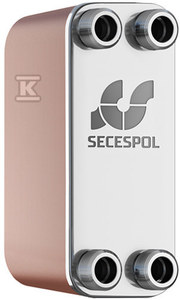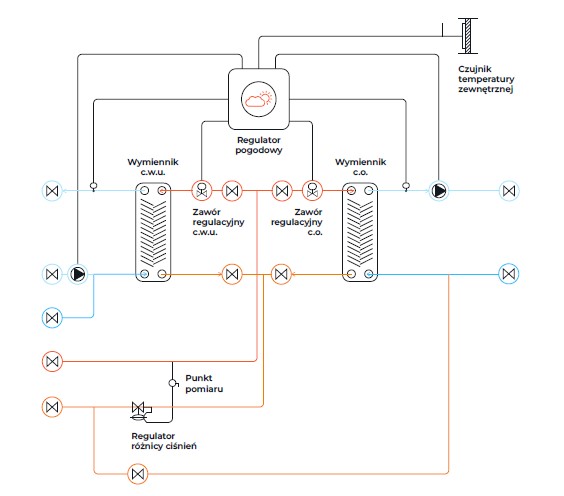Hexonic has introduced asymmetric brazed plate heat exchangers to its offer. The company's engineers designed a smaller exchanger while maintaining the current power of the device. The basic application of the LA21AS exchanger is heating applications - residential heating stations and gas boilers .

Asymmetric brazed plate heat exchangers were designed primarily for heating applications - residential heating substations and gas boilers. A special channel arrangement ensures maximum heat exchange efficiency on the side with a higher flow rate, with minimal pressure drop in the secondary circuit. The biggest advantage of asymmetric heat exchangers is their compact size and the possibility of using smaller pumps
power in heating installations. In many cases the efficiency of asymmetric heat exchangers can be up to 18% higher compared to standard brazed plate heat exchangers.
Check out the Hexonic brand offer at the Onninen wholesaler
Modern plate design in asymmetric heat exchangers
 The asymmetric design of the plate allows independent optimization of the flow of both fluids to achieve savings and maximum thermal efficiency.
The asymmetric design of the plate allows independent optimization of the flow of both fluids to achieve savings and maximum thermal efficiency.
The unique design of the plate allows operation in conditions where one of the factors has a much higher flow rate.
The main advantages of the asymmetric exchanger:
- Compact size
- Up to 18% higher efficiency
- Greater capacity
- Less refrigerant demand
- Greater heat transfer efficiency
- Possibility to use pumps with lower power
- Low carbon footprint
The main advantages of the asymmetric exchanger plate:
- Corrugated cover plate – additional heating channel
- Smaller water pressure drops - secondary side
- Increased maximum water flow - secondary side
- Greater flow turbulence – primary side
The asymmetric heat exchanger is distinguished primarily by its compact size and the possibility of using lower power pumps in central heating installations . The smaller size of devices with asymmetric plates allows them to be widely used, especially where there is not much space.
Compared to standard brazed plate heat exchangers, the efficiency of asymmetric heat exchangers can be up to 18% higher - says Wojciech Miciak, head of Hexonic's Research and Development Department. - The design of the asymmetric plate allows independent optimization of the flow of both fluids, thanks to which users can enjoy maximum thermal efficiency and ultimately save a lot on heating. The asymmetric design of the plate also enables operation in conditions where one of the media has a much higher flow rate. The special arrangement of exchanger channels ensures high efficiency on the refrigerant side with minimal pressure drop in the secondary circuit. Therefore, we assume that the primary purpose of the LA21AS exchanger will be gas boilers and residential heating stations - adds Wojciech Miciak.
Where are asymmetric exchangers used?
Residential heating station
 A housing station, also called a mini station, a housing station or a logotherm, is a compact device that provides heat service in a single residential premises. It transfers heat from the local boiler room or from a heating node powered by the municipal heating network to the premises. This solution gives residents of multi-family buildings individual control over how they use heating and prepare domestic hot water.
A housing station, also called a mini station, a housing station or a logotherm, is a compact device that provides heat service in a single residential premises. It transfers heat from the local boiler room or from a heating node powered by the municipal heating network to the premises. This solution gives residents of multi-family buildings individual control over how they use heating and prepare domestic hot water.
The heat exchange process in mini heat stations takes place using brazed plate heat exchangers. Asymmetric brazed plate exchangers from the L series are used in this application.
Gas boilers
Gas boilers are heating devices that are highly efficient
and efficiency. We distinguish several types of boilers.
Combination gas boilers
They are designed so that one unit can
heat the building and provide domestic hot water (DHW) heated in a flow system. If there is a demand for hot water, the boiler will switch to the mode of heating water drawn from the draw-off point, and after a while returning to heating water for central heating (central heating).
Single-function gas boilers
The basic task of single-function boilers is to heat water in the installation
What To use this type of boiler for heating domestic hot water, you must equip it
it into a storage heater. The coil located in the heater
powered by hot water from the boiler, it maintains the set water temperature.
Both types of boilers can be equipped with the function of heat recovery from exhaust gases, which reduces operating costs. This phenomenon is called condensation, and the boilers are called condensing boilers.
The operation of the boiler is possible thanks to the compact heat exchanger located inside. It is most often an asymmetric brazed plate exchanger. It ensures high comfort of use and excellent performance of the entire system. Its compact dimensions make it possible to limit the dimensions of the entire boiler.